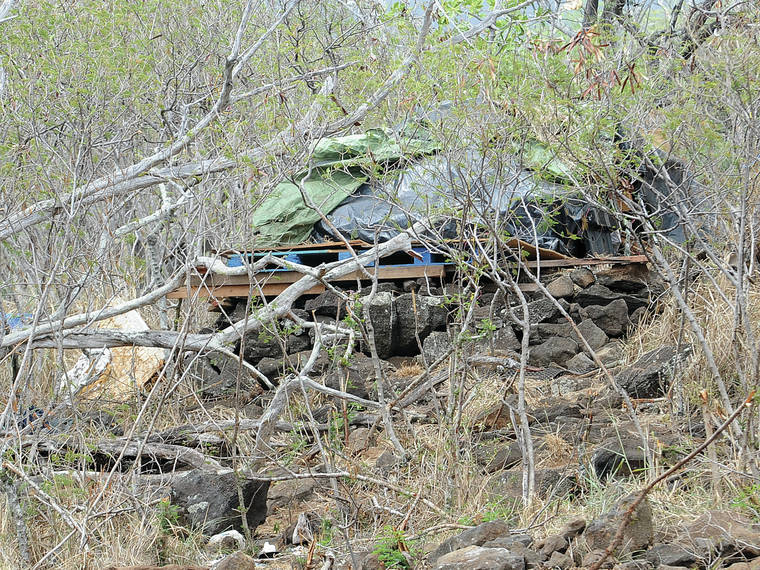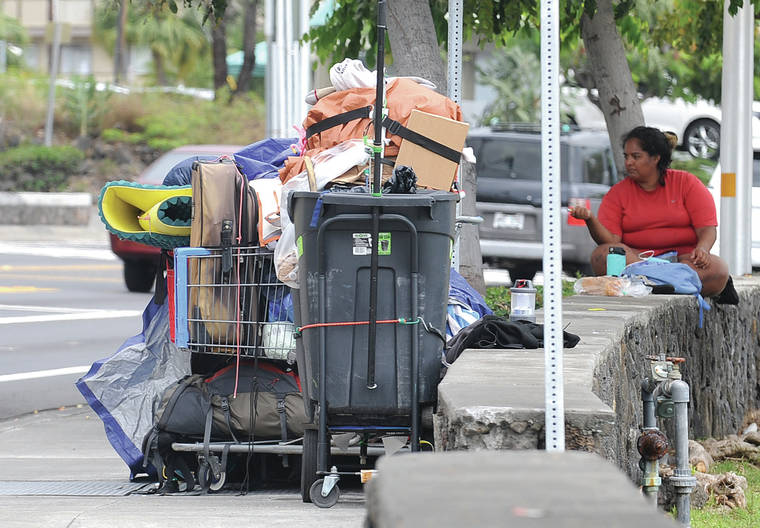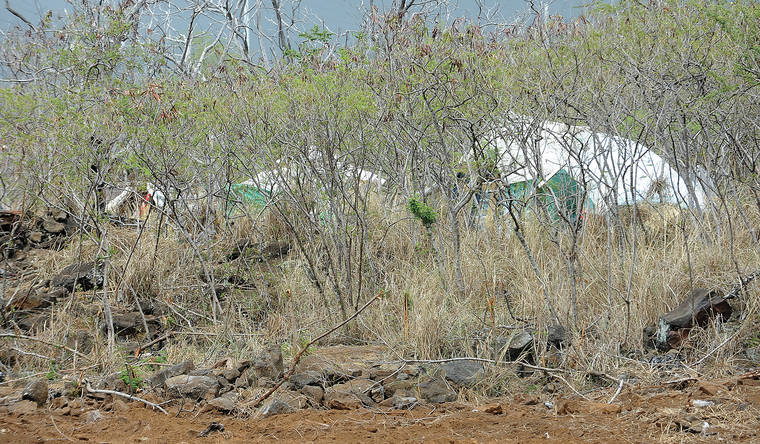 A week after the area was cleared, structures are set up on county property at the Queen Kaahumanu Highway Palani Road intersection. (Laura Ruminski/West Hawaii Today)
A week after the area was cleared, structures are set up on county property at the Queen Kaahumanu Highway Palani Road intersection. (Laura Ruminski/West Hawaii Today) Personal belongings line the sidewalk on Kuakini Highway. (Laura Ruminski/West Hawaii Today)
Personal belongings line the sidewalk on Kuakini Highway. (Laura Ruminski/West Hawaii Today) A week after the area was cleared tents are seen set up on county property at the Queen Kaahumanu Highway Palani Road intersection. (Laura Ruminski/West Hawaii Today)
A week after the area was cleared tents are seen set up on county property at the Queen Kaahumanu Highway Palani Road intersection. (Laura Ruminski/West Hawaii Today)
KAILUA-KONA — An accelerated path to alleviating some of the homeless pressure in Kailua Village began Tuesday at the West Hawaii Civic Center.
Village 9, Hawaii County’s ohana zone-backed homeless housing project, began to assume shape at a day-long brainstorming session between developers, county officials, service providers and community stakeholders. Nothing was decided but interactive group work produced discussion and suggestions that will partially inform the final design.
“We need the community to embrace this,” Barbara Kossow, Hawaii County deputy managing director, said of the collaborative effort. “They’re (considering) what they want this project to look like. … We want it to blend in with the rest of the surroundings.”
Current plans for camp have it butting up against the coming Kealakehe Regional Park as well as in the vicinity of the West Hawaii Civic Center, Kealakehe High School and a Hawaiian Homes development.
The chosen location of Village 9 has long been a point of contention among some West Hawaii residents. While some are concerned homeless will populate a camp situated next to the island’s largest school, others harbor opposing fears that homeless won’t relocate, instead maintaining a sizable presence in Kailua Village and resulting in millions in taxpayer waste.
“You’re going to have some that won’t want to (live there),” Kossow conceded.
That’s why, she added, it’s important to engage with the homeless themselves to find out what would draw them to Village 9 and what might keep them rooted there.
Research of similar projects across the country indicate that creating a sense of community is more important to recruitment efforts than simply building four walls and a roof.
Suggestions to this effect from the nearly 50 people taking part in Tuesday’s session included maximizing common, outdoor spaces, building a walking path to connect every portion of what will be a roughly 15-acre sprawl, using a cluster-style layout of several homes in a circle to pool physical resources, and providing ready access to mental and physical services to promote a supportive environment.
But it may require more than that. The site is several miles from Kailua Village, the homeless hub of West Hawaii. Kossow said the county is discussing mass transit options for Village 9 or possibly some type of shuttle transportation.
The closest commerce option is at the bottom of Kealakehe Parkway, a considerable jaunt on foot from where Village 9 will end up. Hawaii County Planning Director Michael Yee said creating any commercial center within the site could be tricky but wouldn’t be out of the question.
“Everything is always possible, for the most part,” he said.
Planner Jeff Seastrom, who hosted Tuesday’s session, agreed it might be feasible saying mixed-use zoning is possible on the affordable housing portion of the project. That area is roughly the same size as the homeless parcel but is still owned by the Hawaii Housing Finance and Development Corporation.
Seastrom said the HHFDC and the Office of Hawaiian Affairs would have to be consulted and approve any commercial development at Village 9 or the adjacent affordable housing project. Any retailer would also incur a ceded land cost on top of the price of a lease.
Yee added that certain funding mechanisms and their inherent stipulations might also create hurdles toward constructing any commercial area or general store at the camp. However, bringing food trucks in or allowing pop-up shops just off the property are potential solutions some in attendance Tuesday mentioned as workarounds.
As for the generally uncooperative element of some homeless, which includes a criminal element, First Deputy Prosecuting Attorney Dale Ross said programs meant to incentivize residence at Village 9 aren’t off the table.
At the now disbanded Camp Kikaha, which the county constructed next to HOPE Services Hawaii in the Old Kona Industrial Area after clearing Old Airport Park of homeless campers in 2017, such a program was implemented.
Homeless actively engaged and living at the camp but also saddled with bench warrants were afforded opportunity to clear those warrants by performing community service on site. The county provided transportation to the courthouse for relevant court dates.
“It’s very possible” that could be replicated, Ross said.
A second collaborative brainstorming session is scheduled for May. A draft environmental assessment is set for June-July, with a final EA projected for August-September. Work to open a temporary, 5-acre emergency site is planned to begin immediately after, though there is no timeline for its completion.
Developers hope to begin construction on the larger, permanent camp, which will include emergency shelter services, by the end of the year. General cost projections come in around $400 per square foot for structures based on previous homeless housing initiatives across Hawaii, Seastrom said.
Read the full story through West Hawaii Today here.
